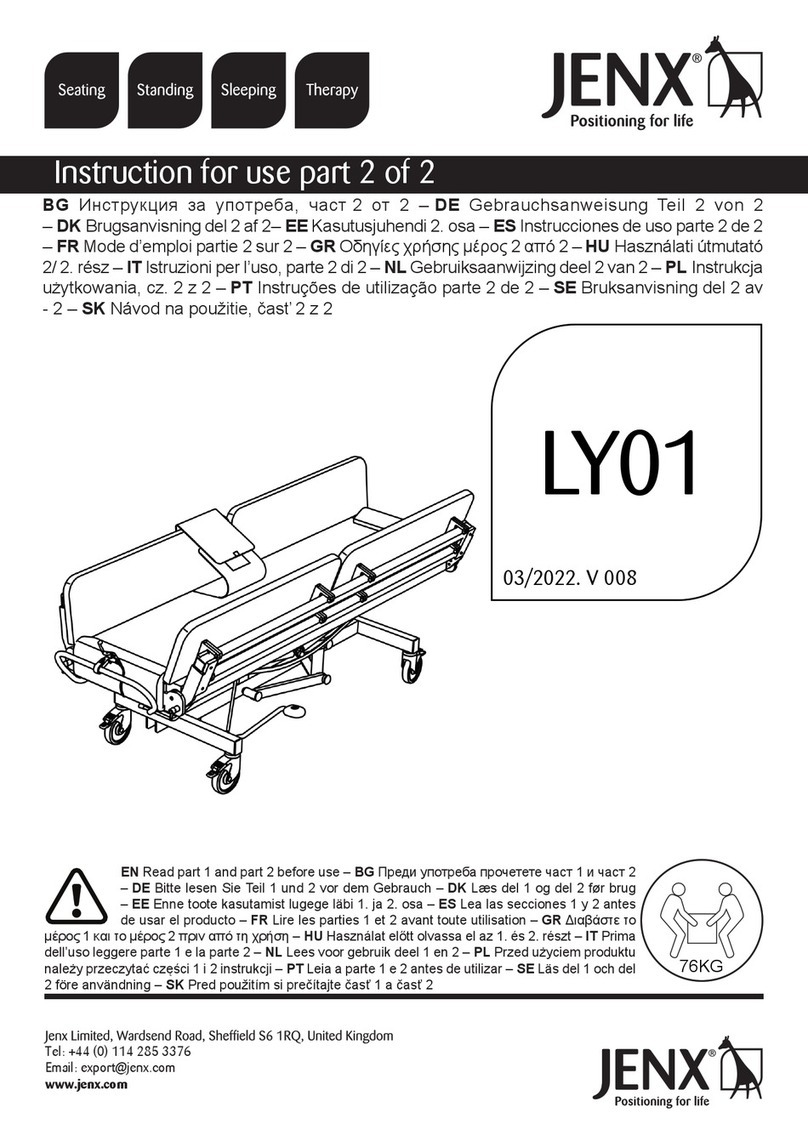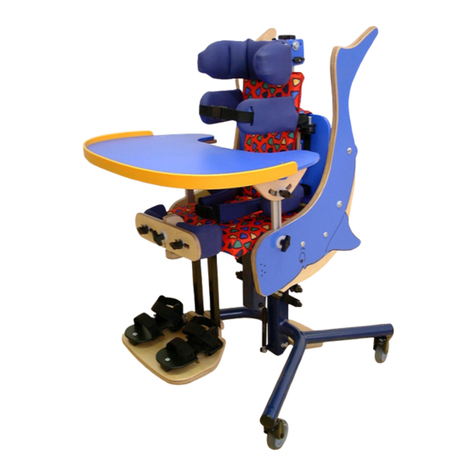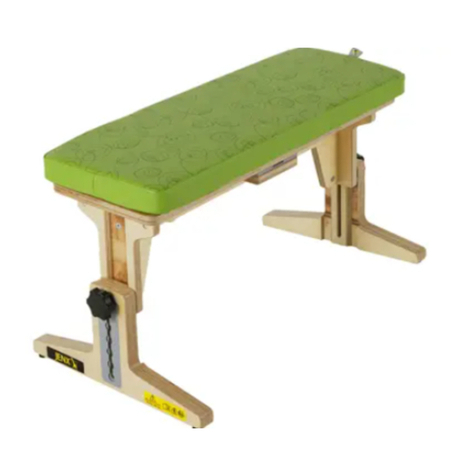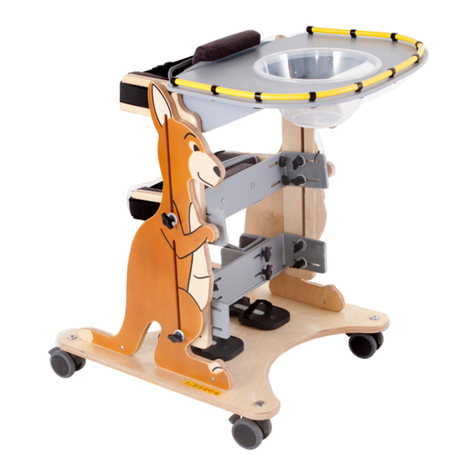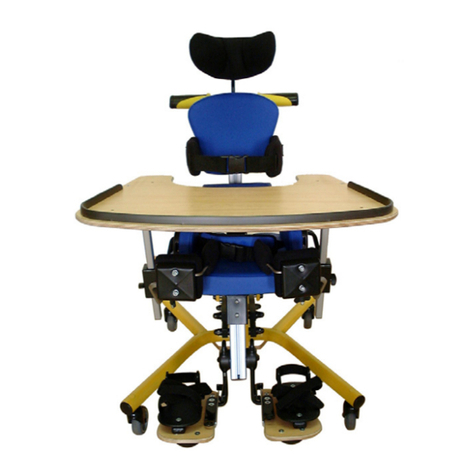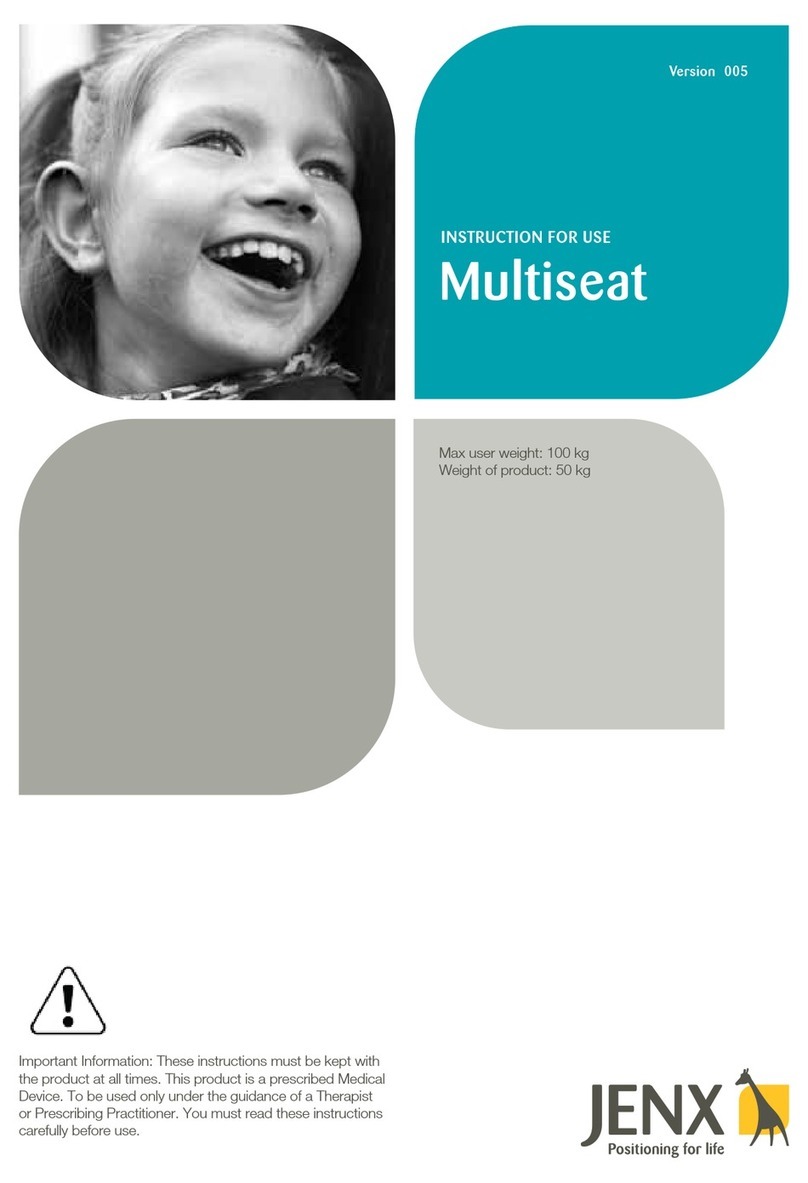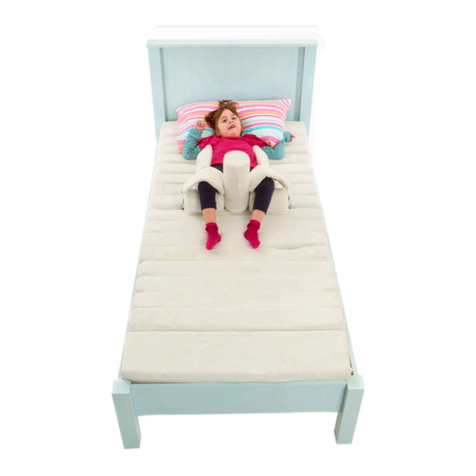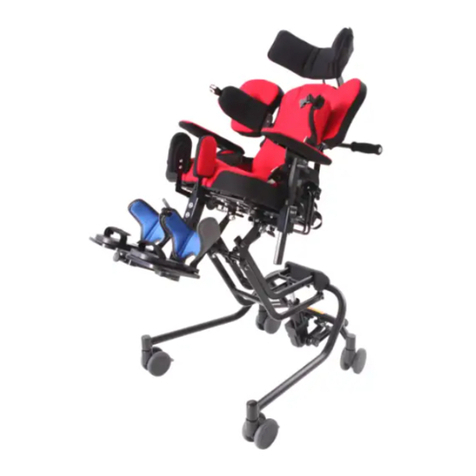Jenx LADYBIRD User manual

Note: Ladybird and Turtle are Prescribed Medical Devices.
To be used only with the guidance of Therapist or Prescribing
Practitioner. Please read these instructions carefully before use.
All Users
GB
Section 2 Pages 9 - 16
Technical User Physiotherapist, Occupational Therapist.
Section 3 Pages 18 - 20
Home User Home or School Carer.
Section 4 Pages 21 - 25
Re-Issue Stores Personnel.
FOR FREE ADVICE ON THE USE OF THIS PRODUCT, PLEASE CONTACT OUR SALES SUPPORT TEAM
Jenx Limited, Wardsend Road, Sheffield, S6 1RQ. Tel: +44 (0)114 285 3376. Fax: +44 (0)114 285 3528. [email protected] www.jenx.com
Ver; 002 June 2009 SJB
1
Section 1 Pages 2 - 8
All Users Safety Information
LADYBIRD & TURTLE
Instruction For Use
Ladybird and Turtle offer supportive prone sitting for young children.
They are particularly suitable for “floppy” children and also for children who have
difficulty achieving straight knees in sitting. Sitting with straight knees helps to
stretch tight knees.
Turtle
Age Guide 1—5 years
Max weight 25Kg
Ladybird
Age Guide 6 months—3 years
Max weight 25Kg

Any service or repair carried out by persons other than a Jenx authorised service person
will invalidate the guarantee and Jenx can accept no liability for any injury or damage so
caused.
IMPORTANT SAFEGUARDS
NEVER LEAVE CHILD UNATTENDED WHILE THEY ARE USING THIS PRODUCT.
FOR FREE ADVICE ON THE USE OF THIS PRODUCT, PLEASE CONTACT OUR SALES SUPPORT TEAM
Jenx Limited, Wardsend Road, Sheffield, S6 1RQ. Tel: +44 (0)114 285 3376. Fax: +44 (0)114 285 3528. [email protected] www.jenx.com
2
Failure to follow instructions, especially with regard to moving parts may pose a risk to the
user. Always read instructions before use.
Do not use this product if you suspect it is faulty or broken.
Contact Jenx Limited immediately for advice. +44 (0) 114 285 3376
This product should be used on a level floor and never on raised or uneven surface.
Do Not use this product as a Mobility Device.
This product contains small parts which could present a choking hazard to small children.
All Users
GB
All Jenx Limited products are tested to current fire regulations. Always keep products away
from naked flames, cigarettes and sources of heat. E.g. Radiators, Heaters etc.
Jenx supply tools to adjust certain products. The tools are supplied for adjustments to be
made by the therapist only. Store in a safe place. Keep Away from children.
Do Not make adjustments, other than instructed to do so.
Secure the child by using straps provided before you begin to make any other
adjustments. Ensure the straps are adjusted for each child and for changes of clothing.
Assemble product fully before use. Please contact Jenx Limited if you have any problems
at this stage.
Look after your product well, clean regularly and do not use abrasive cleaners.
This product conforms to the European Medical Devices Directive. It has not been tested
in conjunction with other manufacturers products. Do not add any accessories other than
Jenx Limited accessories to this product.
If in doubt, contact us for advice. +44 (0)114 285 3376
When not in use store this product in a dry place that is not subject to extremes of
temperature. E.g. Places not to store this product are attics or garden sheds.
Ensure your Therapist has signed the inspection log as “Set Up” before using
the product. If this product has not been set up by your Therapist
DO NOT USE THE PRODUCT
All belts and harnesses should be used at all times. For therapy purposes it may be
necessary to deviate from this rule and any deviation should be fully documented as part
of a Risk Assessment or Therapy Programme and all relevant staff and carers
appropriately trained. Secure client with straps before adjusting product. Ensure finger’s
width between safety strap and client to prevent over tightening or client moving to
inappropriate position. Adjust straps for each client and changes of clothing. Minimum
Velcro overlap: 3 inches (7.5cm) on all straps. If strap is not long enough, DO NOT USE
PRODUCT

FOR FREE ADVICE ON THE USE OF THIS PRODUCT, PLEASE CONTACT OUR SALES SUPPORT TEAM
Jenx Limited, Wardsend Road, Sheffield, S6 1RQ. Tel: +44 (0)114 285 3376. Fax: +44 (0)114 285 3528. [email protected] www.jenx.com
3
All Users
GB
SAFETY LABEL
Batch number
The batch number is written on
the fire label (see picture below)
which is located on the inside of
the product body. Or in some
instances on the underside of
the seat. Please quote this
number on all correspondence.
SAFETY LABEL
Each Jenx product has a pictorial safety label attached.
Refer to explanation below.
Warning / Attention.
Please read Instructions
Always fasten and adjust positioning straps and belts to suit the
child. Adjust to suit changes in clothing. Allow one fingers width
between the belt and the child.
DO NOT USE as a mobility device
Never use product on rough ground or uneven surface.
Only use indoors
Do not leave child unattended
Conforms to CE Marking Regulations
Medical Devices Directive (MDD) 93/42 EEC
Maximum user weight

CARE AND CLEANING INSTRUCTIONS
4
Fabrics, Vinyl's and Cloth covers
1. Minor spills can be removed with kitchen roll and the area wiped with clean water.
2. Staining should be removed as quickly as possible after contact.
3. Do not rub, rubbing will spread the stain over a larger area and may distort the
surface texture of the fabric.
4. For water based spills such as food, drink and vegetable oils, blot up the spill by
applying pressure with non-coloured paper towels, tissues or dry absorbent cloths.
Soak a small piece of cloth in a solution of mild detergent and warm water (use
cold water for blood), using a small amount of the solution at a time and with a
dabbing or blotting motion, work inwards from the edge of the stain to prevent it
spreading. Do not over wet. Excessive soaking may cause rings on the surface
spreading the stain further and may also damage the fabric or foam.
5. This step may need to be repeated and is dependent on the nature of the stain and
the amount of staining present. Continue treatment until stain is removed, always
remembering to remove excess moisture from the fabric prior to the next
treatment.
6. Rinse by applying clear tepid water using a small piece of non-coloured sponge or
clean white cloth, again working inwards from the edge of the treated area.
7. Disinfectants which do not contain organic solvents may be used according to the
manufacturer’s directions. Antibacterial spray or wipes can be used, be sure to dry
the product before use.
8. Do not soak the fabric.
9. Do not use organic solvents or dry cleaning fluids. Do not use abrasive cleaners.
10. For disinfectant purposes, a small quantity of household bleach diluted with water
(no more than 3% bleach) can be used, take care to rinse with water.
11. Do not use industrial bleaches such as Caustic Soda or Sodium Hypochlorite
12. Always ensure that the product is dry before use.
Wooden Products and Parts
1. For deep cleaning a low pressure Steam Cleaner can be used.
2. Do Not use solvents of any kind to clean Jenx Products.
3. Soap and water or antibacterial spray can be used.
4. Check for breaks or splintering of the wood before re-issuing.
5. Daily cleaning: Spray polish or wax polish can be used.
Metal Frames and Coated Parts.
1. For deep cleaning a low pressure Steam Cleaner can be used.
2. Do Not use solvents of any kind to clean Jenx Products.
3. Soap and water or antibacterial spray can be used.
4. Daily cleaning: wipe framework down with a damp cloth.
FOR FREE ADVICE ON THE USE OF THIS PRODUCT, PLEASE CONTACT OUR SALES SUPPORT TEAM
Jenx Limited, Wardsend Road, Sheffield, S6 1RQ. Tel: +44 (0)114 285 3376. Fax: +44 (0)114 285 3528. [email protected] www.jenx.com
All Users
GB

MAINTENANCE
Daily Checks of the equipment should be carried out by carers. These checks are
not technical but a basic understanding of the product is needed. Multiple daily
checks may be needed in schools or therapy rooms where the products are used by
multiple users.
Daily Checks
• Replace any lost or worn washers or bolts.
• Check tray for damage. Ensure that the tray edging is secure and that the tray
is clean and free of any rough or sharp corners.
• Check all upholstery for any signs of wear and tear.
• Brush Velcro® to remove fluff.
• Check wooden parts for splitting or splintering.
• Check straps for fraying and missing or broken buckles.
• Clean any stains or spillages.
• Contact Jenx Limited if any accessories not manufactured by Jenx Limited
have been attached to the product. Unauthorised accessories may affect the
safety of this product and invalidate your warranty.
We recommend that on a monthly basis a competent person who is familiar with
this piece of equipment and who has been trained in its use should carry out a more
detailed check
Monthly Checks
• Check all nuts and bolts are secured and that none is missing.
• Check all mechanical movements operate fully.
• Check the structure of the product for signs of fatigue or splintering.
• Castors: Lift base and check each wheel to ensure it is not loose or worn.
Remove any grease or dirt that has built up on the wheels, check that the
brake stops the wheels rotating (where applicable).
• Check gas springs for creep by placing a weight on the chair at the highest
setting, (simulating the child) and leave for 1 hour. If the product has reduced
significantly in height contact our Customer Service Department for advice.
Please ensure the name of the therapist who recommended the equipment is noted
on the check/inspection log, along with the competent person who has been trained
in the use of the equipment. Please also ensure that this is updated for changes in
staff. Please note any “Set up” procedures should always be recorded.
5
FOR FREE ADVICE ON THE USE OF THIS PRODUCT, PLEASE CONTACT OUR SALES SUPPORT TEAM
Jenx Limited, Wardsend Road, Sheffield, S6 1RQ. Tel: +44 (0)114 285 3376. Fax: +44 (0)114 285 3528. [email protected] www.jenx.com
All Users
GB

6
PRODUCT INDUCTION and HAND OVER
This product is a Prescribed Medical device as such it is important that all users understand the
use and adjustments this product offers. This booklet shows the range of adjustments and gives
guidelines for each type of user to follow.
Technical users
This section refers to Physiotherapist, Occupational Therapist.
Ensure you read all sections in this booklet and are fully familiar with all adjustments.
As well as the selection, prescription and set up of the product to suit the child’s needs.
The technical user has the responsibility for the induction of the Home User or Carer, ensuring
that the Home user has:
• Familiarity with the product. What to use and what not to use.
• Understanding of the care and cleaning procedures.
• Understanding the safety aspects of the product.
A formal handover procedure should be adopted for this product. Use the recording sheet at the
rear of this booklet to record set ups and changes to the product.
Jenx Limited offer Product Courses for Technical Users please contact us for more information.
Home User
This section refers to Home or School Carer.
This product is a Prescribed Medical device it should only be used with the guidance of a
Physiotherapist or OT.
Do not perform any other adjustment than instructed to do so.
The Home User section of this guide gives the adjustments needed to aid the daily use only.
Any other adjustments are only to be preformed by the therapist.
Re-Issue
This section refers to Stores Personnel.
Stores personnel must follow the checks and maintenance guide before re issue. The MHRA
release regular bulletins regarding product updates and issues, these should be regularly
monitored.
• Records should be kept on all products serviced or re-issued. Repairs or replaced parts
should be traceable.
• The batch number identifier should always stay with the product and never be removed.
• Instructions should always be issued with the product. Copies are available from Jenx
limited or can be downloaded from www.jenx.com
• Technical users should always be informed when a product is issued to a home for set up
purposes.
• If the product is to be redelivered ensure adequate and secure packaging is used.
• If in any doubt to the safety of this product do not issue, contact Jenx Limited for advice.
Jenx Limited offer Stores Courses for Stores Personnel. The course gives guidance for:
• Maintenance
• Inspection the products
• Regulatory information
• Cleaning
Please contact us for more information.
FOR FREE ADVICE ON THE USE OF THIS PRODUCT, PLEASE CONTACT OUR SALES SUPPORT TEAM
Jenx Limited, Wardsend Road, Sheffield, S6 1RQ. Tel: +44 (0)114 285 3376. Fax: +44 (0)114 285 3528. [email protected] www.jenx.com
All Users
GB

SPECIFICATIONS
7
FOR FREE ADVICE ON THE USE OF THIS PRODUCT, PLEASE CONTACT OUR SALES SUPPORT TEAM
Jenx Limited, Wardsend Road, Sheffield, S6 1RQ. Tel: +44 (0)114 285 3376. Fax: +44 (0)114 285 3528. [email protected] www.jenx.com
All Users
GB
Size Guide
Max weight of child 25kg
Overall min height of Turtle 520mm
Floor space required 720 x 570mm
Product weight 15.5kg
Descriptions Min Max
Abduction block to backrest Up to 230mm
Abduction block to front edge Up to 300mm
As above with extension Up to 450mm
Hip width 110mm 260mm
Seat to under armpit 110mm 210mm
Seat angle 10º 15º
Seat to top of chest pad 175mm 290mm
Tray size (work area) 485 × 345mm
Size Guide
Max weight of child 25kg
Overall min height of Turtle 450mm
Floor space required 500 x 600mm
Product weight 10.5kg
Ladybird
Turtle
Descriptions Min Max
Abduction block to backrest Up to 290mm
Abduction block to front edge Up to 400mm
As above with extension Up to 550mm
Hip width 110mm 300mm
Seat to under armpit 110mm 290mm
Seat angle 10º 15º
Seat to top of chest pad 210mm 365mm
Tray size (work area) 535 × 375mm

8
WARRANTY
Jenx Limited warrants that the goods manufactured by Jenx
Limited will be free from defects in material and workmanship
for a period of 24 months* from the date of purchase.
Jenx Limited has sole obligation under this warranty to repair
or replace, at our discretion for any part or goods proving
defective within the terms of this period. The buyer must
provide immediate notice of the claimed defect.
Jenx Limited reserves the right to inspect the part or goods at
the buyer’s premises.
In the event of an exchange or return, where a certain model
under this warranty is discontinued, Jenx Limited reserves the
right to replace with a new model of a similar quality and price.
The warranty does not cover the product for repair or
replacement due to failure or damage through; abuse, neglect,
accident, improper repair, exposure to corrosive or abrasive
material, weather, failure to follow care and cleaning
instructions or alterations or modifications carried out by any
person other than a Jenx Limited authorised person.
*For purchases placed on or after the 1st January 2006. Previous purchases will have 12 month warranty
from date of purchase
FOR FREE ADVICE ON THE USE OF THIS PRODUCT, PLEASE CONTACT OUR SALES SUPPORT TEAM
Jenx Limited, Wardsend Road, Sheffield, S6 1RQ. Tel: +44 (0)114 285 3376. Fax: +44 (0)114 285 3528. [email protected] www.jenx.com
All Users
GB

9
Technical User
GB
FOR FREE ADVICE ON THE USE OF THIS PRODUCT, PLEASE CONTACT OUR SALES SUPPORT TEAM
Jenx Limited, Wardsend Road, Sheffield, S6 1RQ. Tel: +44 (0)114 285 3376. Fax: +44 (0)114 285 3528. [email protected] www.jenx.com
Note: Ladybird and Turtle are Prescribed Medical Devices.
To be used only with the guidance of Therapist or Prescribing
Practitioner. Please read these instructions carefully before use.
The adjustments contained in the Red Section of this booklet should only be carried
out by a suitably trained Therapist or Prescribing Practitioner.
Ladybird and Turtle offer supportive prone sitting for young children.
They are particularly suitable for “floppy” children and also for children who have
difficulty achieving straight knees in sitting. Sitting with straight knees helps to
stretch tight knees.
Turtle
Age Guide 1—5 years
Max weight 25Kg
Ladybird
Age Guide 6 months—3 years
Max weight 25Kg
LADYBIRD & TURTLE
Instruction For Use
Section 2 Pages 9 - 16
Technical User Physiotherapist, Occupational Therapist.
Section 3 Pages 18 - 20
Home User Home or School Carer.
Section 4 Pages 21 - 25
Re-Issue Stores Personnel.
Section 1 Pages 2 - 8
All Users Safety Information

The Turtle adjustments are shown, the Ladybird adjustments are exactly the same.
1. Chest Strap: Adjusts in length to hold your child safely.
2. Back Support: Adjusts forwards to change the seat length.
3. Shoulder Support: Adjusts up and down and for angle.
4. Hip Support Pads: Multi-grip™ supports can be “moulded” to your child’s shape.
5. Hip Support Angle: Create tailor made support for the contour of your child.
6. Tray Height: Raises and lowers height of tray .
7. Tray Extension Wings: Flip away for ease of entry, adjust to support broader or
narrower children.
8. Abduction Block: Adjusts to create correct leg length and in conjunction with the
chest pad, creates the correct prone position.
9. Chest Pad: Adjusts for height and to create the correct prone position .
10. Seat Angle: Adjusts from 5 degrees to 15 degrees prone.
11. Seat Extension: Add this to support the whole of your child’s legs as they grow.
12. Tray Position: Adjusts towards and away from your child.
Main Areas of Adjustment
10
Always secure the child by using all of the positioning straps and safety straps provided. Velcro
should overlap by at least 3 inches
(7.5 cm)
on all straps before you begin to make any other
adjustments. Ensure the safety strap and positioning strap are adjusted for each child and for
changes of clothing.
Technical User
GB
FOR FREE ADVICE ON THE USE OF THIS PRODUCT, PLEASE CONTACT OUR SALES SUPPORT TEAM
Jenx Limited, Wardsend Road, Sheffield, S6 1RQ. Tel: +44 (0)114 285 3376. Fax: +44 (0)114 285 3528. [email protected] www.jenx.com
Do not use this product if you suspect it is faulty or broken.
Contact Jenx Limited immediately for advice. +44 (0) 114 285 3376
Never Leave your child unattended while using this product
1
5
2
3
4
12
11
6&8
7
9
10

11
Technical User
GB
FOR FREE ADVICE ON THE USE OF THIS PRODUCT, PLEASE CONTACT OUR SALES SUPPORT TEAM
Jenx Limited, Wardsend Road, Sheffield, S6 1RQ. Tel: +44 (0)114 285 3376. Fax: +44 (0)114 285 3528. [email protected] www.jenx.com
Do not use this product if you suspect it is faulty or broken.
Contact Jenx Limited immediately for advice. +44 (0) 114 285 3376
Never Leave your child unattended while using this product
Making & using the adjustments
Always secure the child by using all of the positioning straps and safety straps provided. Velcro
should overlap by at least 3 inches
(7.5 cm)
on all straps before you begin to make any other
adjustments. Ensure the safety strap and positioning strap are adjusted for each child and for
changes of clothing.
POSITIONING SUGGESTIONS GIVEN IN THIS SECTION SHOULD BE TREATED AS A GUIDE ONLY. YOU SHOULD
ALWAYS CONSULT YOUR THERAPIST OR MEDICAL PRACTITIONER BEFORE USING THIS PRODUCT.
The Chest Strap.
HOW?
To alter the length of the chest strap, thread the strap out of the tri-glide Fig 1. move the tri-glide and pull
the strap through the end of the buckle until it is the length that you want Fig 2. Secure the strap at this
length by passing it through the tri-glide again Fig 3.
WHY?
This is a safety strap to prevent your child falling backwards from the seat if they extend.
Attaching/Fitting The Back Support.
HOW?
To fix the back support to the seat, insert the curved brackets underneath the back of the seat over the
wooden locater and tighten the wingnut underneath Fig 4. The seat can be used with or without the back
support according to the child’s needs.
WHY?
The back support offers Multigrip™ support to hold the hips in position. The back support also has a
shoulder support to make sure that a child who extends strongly cannot fall out.
Fig 3
Fig 1 (tri-glide) Fig 2 (buckle) Fig 3 (tri-glide)
Fig 4

12
Technical User
GB
FOR FREE ADVICE ON THE USE OF THIS PRODUCT, PLEASE CONTACT OUR SALES SUPPORT TEAM
Jenx Limited, Wardsend Road, Sheffield, S6 1RQ. Tel: +44 (0)114 285 3376. Fax: +44 (0)114 285 3528. [email protected] www.jenx.com
Making & Using the Adjustments
Do not use this product if you suspect it is faulty or broken.
Contact Jenx Limited immediately for advice. +44 (0) 114 285 3376
Never Leave your child unattended while using this product
Always secure the child by using all of the positioning straps and safety straps provided. Velcro
should overlap by at least 3 inches
(7.5 cm)
on all straps before you begin to make any other
adjustments. Ensure the safety strap and positioning strap are adjusted for each child and for
changes of clothing.
POSITIONING SUGGESTIONS GIVEN IN THIS SECTION SHOULD BE TREATED AS A GUIDE ONLY. YOU SHOULD
ALWAYS CONSULT YOUR THERAPIST OR MEDICAL PRACTITIONER BEFORE USING THIS PRODUCT.
WHY?
Adjust the shoulder support so the top edge is in line with the top of the child’s shoulders and use the angle
adjustment to keep the support about 30mm from the child. This will help to prevent a child who extends
strongly from falling out.
The Shoulder Support.
HOW?
The height of the shoulder support can be adjusted by loosening the wingnut at the back of the post Fig 5.
and moving the shoulder support to the required height. Tighten afterwards. The angle of the shoulder
support can be adjusted by loosening the wingnut in the curved slot at the base of the post Fig 6. Tighten
when correct position is found.
WHY?
The Multigrip™ hip support adjusts for height, angle and forward & back. This means you can support the
child’s back at just the right angle to keep their hips in place. They can mould so the child is supported all
around giving them a very stable sitting base.
Multigrip™Hip Supports.
HOW?
These are designed to mould around your child’s hips
to offer maximum support when seated. To mould
around your child simply loosen the black knobs
which can be seen showing through the holes in the
multigrip cover Fig 7. Do not over-loosen them.
Adjust support to fit and tighten knobs again.
Fig 6Fig 5
Fig 7

13
Technical User
GB
FOR FREE ADVICE ON THE USE OF THIS PRODUCT, PLEASE CONTACT OUR SALES SUPPORT TEAM
Jenx Limited, Wardsend Road, Sheffield, S6 1RQ. Tel: +44 (0)114 285 3376. Fax: +44 (0)114 285 3528. [email protected] www.jenx.com
Making & Using the Adjustments
Do not use this product if you suspect it is faulty or broken.
Contact Jenx Limited immediately for advice. +44 (0) 114 285 3376
Never Leave your child unattended while using this product
POSITIONING SUGGESTIONS GIVEN IN THIS SECTION SHOULD BE TREATED AS A GUIDE ONLY. YOU SHOULD
ALWAYS CONSULT YOUR THERAPIST OR MEDICAL PRACTITIONER BEFORE USING THIS PRODUCT.
Always secure the child by using all of the positioning straps and safety straps provided. Velcro
should overlap by at least 3 inches
(7.5 cm)
on all straps before you begin to make any other
adjustments. Ensure the safety strap and positioning strap are adjusted for each child and for
changes of clothing.
WHY?
Holding the child’s hips and lower back in the right position forms the basis of their sitting position.
The better the position of their hips and back, the better their overall posture and function will be.
Hip Support Angle.
HOW?
The hip support fixes to the back post with four small
wingnuts Fig 8. By loosening these, the position of the hip
support can be adjusted forward and back and also for height
and angle. This adjustment is important to support the small
of the child’s back and keep the hips tipped forward at the
top. Tighten all wingnuts after any adjustment.
Tray Height & Position
HOW?
To fix the tray to Turtle place the tray support post over the screw in the centre of the seat Fig 9. Turn the
black handwheel to secure. The tray height can also be adjusted here.
To adjust the position of the tray on the seat, loosen the four black handwheels which are located just
under the surface of the tray Fig 10. The tray can then be moved toward and away from the child and can
be tilted. Tighten all handwheels after any adjustment.
ONLY TURN THE WINGNUTS TWICE OR THE BARREL NUT WILL DIS-ENGAGE
Fig 8
Fig 9 Fig 10
WHY?
Moving the tray towards, or away from your child directly affects the position of the hips and pelvis. This is
important to achieve and maintain a therapeutic position. The tray chest pad should always be forward of
the position of the abduction block to ensure that your child is sitting prone. To sit prone, the angle at your
child’s hips should be 90 degrees or less. Their weight should be supported entirely at the front.
Clear all items from the tray before adjustment.
Do not use hot or cold drinks on the tray while in the angled position.

14
Technical User
GB
FOR FREE ADVICE ON THE USE OF THIS PRODUCT, PLEASE CONTACT OUR SALES SUPPORT TEAM
Jenx Limited, Wardsend Road, Sheffield, S6 1RQ. Tel: +44 (0)114 285 3376. Fax: +44 (0)114 285 3528. [email protected] www.jenx.com
Making & Using the Adjustments
Do not use this product if you suspect it is faulty or broken.
Contact Jenx Limited immediately for advice. +44 (0) 114 285 3376
Never Leave your child unattended while using this product
POSITIONING SUGGESTIONS GIVEN IN THIS SECTION SHOULD BE TREATED AS A GUIDE ONLY. YOU SHOULD
ALWAYS CONSULT YOUR THERAPIST OR MEDICAL PRACTITIONER BEFORE USING THIS PRODUCT.
Always secure the child by using all of the positioning straps and safety straps provided. Velcro
should overlap by at least 3 inches
(7.5 cm)
on all straps before you begin to make any other
adjustments. Ensure the safety strap and positioning strap are adjusted for each child and for
changes of clothing.
WHY?
To allow the child to be taken out of the seat without removing the tray and to offer complete upper trunk
control when needed. The extension wings should be used to ensure that your child’s spine is kept in a
straight line.
Tray Extension Wings and Side Panels .
HOW?
Under the tray there are two black wing nuts Fig 11. By loosening these, it is possible to move the
extension wings to fit snugly to your child to support their trunk. These same wing nuts are loosened to
move the extension wings right out of the way to create lots of space for when you place your child into the
Ladybird/Turtle or when you take them out. Loosen the wing nuts, push the extension wings away from the
tray and then out to the side. This adjustment means that the tray does not need to be removed to put
your child into the chair. Take care that the L-shaped slots are not left exposed to trap the child’s fingers.
Tighten wingnuts after any adjustment.
To adjust the height of the side pads, using the Allen key supplied loosen the screws which attach the side
pads Fig 12 and move along the slot to the required position.
The tray extension wings are also interchangeable, enabling the side pads to have more height adjustment.
To do this using the Allen key supplied remove the two flat head screws in the tray extension wings, turn
the extension wing upside down, swapping right for left replacing the screws on the other side of the
extension wing. Remove the flat head screws which attach the side pads and turn them over. Replace the
screws. Tighten all screws after any adjustment.
Fig 11 Fig 12
Clear all items from the tray before adjustment.
Do not use hot or cold drinks on the tray while in the angled position.

15
Technical User
GB
FOR FREE ADVICE ON THE USE OF THIS PRODUCT, PLEASE CONTACT OUR SALES SUPPORT TEAM
Jenx Limited, Wardsend Road, Sheffield, S6 1RQ. Tel: +44 (0)114 285 3376. Fax: +44 (0)114 285 3528. [email protected] www.jenx.com
Do not use this product if you suspect it is faulty or broken.
Contact Jenx Limited immediately for advice. +44 (0) 114 285 3376
Never Leave your child unattended while using this product
Making & Using the Adjustments
POSITIONING SUGGESTIONS GIVEN IN THIS SECTION SHOULD BE TREATED AS A GUIDE ONLY. YOU SHOULD
ALWAYS CONSULT YOUR THERAPIST OR MEDICAL PRACTITIONER BEFORE USING THIS PRODUCT.
Always secure the child by using all of the positioning straps and safety straps provided. Velcro
should overlap by at least 3 inches
(7.5 cm)
on all straps before you begin to make any other
adjustments. Ensure the safety strap and positioning strap are adjusted for each child and for
changes of clothing.
Abduction Block
HOW?
To make an adjustment to the position of the abduction
block, unfasten the press-studs and pull back the pad
from the curved plastic. Using the Allen key supplied
loosen the two flat head screws which secure the plastic
Fig 13. and move it to the required position. Tighten
screws afterwards and replace the pad on the press-
studs.
WHY?
The abduction block helps to prevent adduction of the
legs and contributes to the correct position of the hips.
The angle of the hips is created by adjusting the
abduction block and the chest pad on the tray to ensure
that your child sits prone.
WHY?
The chest pad is your child’s main support in prone sitting. The pad should be at a height to support your
child over their breastbone ( sternum). Pressure here not only supports your child but can encourage head
control and improve arm function. This position will encourage shoulder protraction and arms are therefore
able to reach the tray more easily.
Chest Pad
HOW?
The chest pad is independently adjustable from the rest of the tray by loosening the two bolts Fig 14. To
access these bolts remove the pad from the tray using the Allen key provided loosen the bolt shown in Fig
15. Adjust to the required height and re-tighten.
Fig 15
Fig 13
Fig 14

16
Technical User
GB
FOR FREE ADVICE ON THE USE OF THIS PRODUCT, PLEASE CONTACT OUR SALES SUPPORT TEAM
Jenx Limited, Wardsend Road, Sheffield, S6 1RQ. Tel: +44 (0)114 285 3376. Fax: +44 (0)114 285 3528. [email protected] www.jenx.com
Do not use this product if you suspect it is faulty or broken.
Contact Jenx Limited immediately for advice. +44 (0) 114 285 3376
Never Leave your child unattended while using this product
Making & Using the Adjustments
Always secure the child by using all of the positioning straps and safety straps provided. Velcro
should overlap by at least 3 inches
(7.5 cm)
on all straps before you begin to make any other
adjustments. Ensure the safety strap and positioning strap are adjusted for each child and for
changes of clothing.
POSITIONING SUGGESTIONS GIVEN IN THIS SECTION SHOULD BE TREATED AS A GUIDE ONLY. YOU SHOULD
ALWAYS CONSULT YOUR THERAPIST OR MEDICAL PRACTITIONER BEFORE USING THIS PRODUCT.
WHY?
The seat angle should be positioned to suit the child’s specific needs. If you are unsure of the correct
seating position, please consult your therapist or medical practitioner for advice.
Prone sitting can be used to help encourage head control and better arm function. Your child’s weight is
supported through the chest pad. Altering the angle of the seat will increase or decrease the amount of
weight going through the chest pad. For many children a point is reached where their head control
improves, their shoulders drop forward and their arms move more freely. For many children it will be best
to introduce them to prone sitting using a steep angle. This means that they are receiving a higher level of
support than with the seat at a flatter angle.
The Seat Angle
HOW?
The seat angles between 10° and 15°. To adjust the
angle, loosen the two wing nuts on the sides of Turtle
Fig 16. Adjust the seat to the required angle and
tighten wing nuts.
WHY?
To support your child’s legs as they grow longer. To help to keep your child’s knees straight and flexible,
they must be supported all along their length.
Seat Extension
HOW?
The seat extension fits at the front of the seat. Use the flap of fabric to keep it in position by attaching the
velcro strip. When the seat extension is not in use the flap can be tucked underneath the front of the seat
out of the way. Fig 17.
Fig 16
Fig 17

17

18
Home User
GB
FOR FREE ADVICE ON THE USE OF THIS PRODUCT, PLEASE CONTACT OUR SALES SUPPORT TEAM
Jenx Limited, Wardsend Road, Sheffield, S6 1RQ. Tel: +44 (0)114 285 3376. Fax: +44 (0)114 285 3528. [email protected] www.jenx.com
Note: Ladybird and Turtle are Prescribed Medical Devices.
To be used only with the guidance of Therapist or Prescribing
Practitioner. Please read these instructions carefully before use.
LADYBIRD & TURTLE
Instruction For Use
Turtle
Age Guide 1—5 years
Max weight 25Kg
Ladybird
Age Guide 6 months—3 years
Max weight 25Kg
Read the All User Section first. The adjustments contained in the Light Blue Section of this booklet
should be carried out by a competent person.
Section 2 Pages 9 - 16
Technical User Physiotherapist, Occupational Therapist.
Section 3 Pages 18 - 20
Home User Home or School Carer.
Section 4 Pages 21 - 25
Re-Issue Stores Personnel.
Section 1 Pages 2 - 8
All Users Safety Information

19
Making & Using the Adjustments
Your Therapist has set the adjustments for this product to suit your child.
The adjustments given in this section are to aid the daily use only.
Your therapist will make any adjustment necessary. Do not make any other adjustment.
Home User
GB
FOR FREE ADVICE ON THE USE OF THIS PRODUCT, PLEASE CONTACT OUR SALES SUPPORT TEAM
Jenx Limited, Wardsend Road, Sheffield, S6 1RQ. Tel: +44 (0)114 285 3376. Fax: +44 (0)114 285 3528. [email protected] www.jenx.com
Do not use this product if you suspect it is faulty or broken.
Contact Jenx Limited immediately for advice. +44 (0) 114 285 3376
Never Leave your child unattended while using this product
Always secure the child by using all of the positioning straps and safety straps provided. Velcro
should overlap by at least 3 inches
(7.5 cm)
on all straps before you begin to make any other
adjustments. Ensure the safety strap and positioning strap are adjusted for each child and for
changes of clothing.
The Chest Strap.
HOW?
To alter the length of the chest strap, thread the strap out of the tri-glide Fig 1. move the tri-glide and pull
the strap through the end of the buckle until it is the length that you want Fig 2. Secure the strap at this
length by passing it through the tri-glide again Fig 3.
WHY?
This is a safety strap to prevent your child falling backwards from the seat if they extend.
Attaching/Fitting The Back Support.
HOW?
To sit your child in the ladybird or turtle the back support needs to be removed by unscrewing the wing nut
and sliding the back support out. To fix the back support to the seat, insert the curved brackets
underneath the back of the seat over the wooden locater and tighten the wingnut underneath Fig 4.
WHY?
The back support offers Multigrip™ support to hold the hips in position. The back support also has a
shoulder support to make sure that a child who extends strongly cannot fall out.
Fig 3
Fig 1 (tri-glide) Fig 2 (buckle) Fig 3 (tri-glide)
Fig 4

20
Home User
GB
FOR FREE ADVICE ON THE USE OF THIS PRODUCT, PLEASE CONTACT OUR SALES SUPPORT TEAM
Jenx Limited, Wardsend Road, Sheffield, S6 1RQ. Tel: +44 (0)114 285 3376. Fax: +44 (0)114 285 3528. [email protected] www.jenx.com
Making & Using the Adjustments
Do not use this product if you suspect it is faulty or broken.
Contact Jenx Limited immediately for advice. +44 (0) 114 285 3376
Never Leave your child unattended while using this product
Always secure the child by using all of the positioning straps and safety straps provided. Velcro
should overlap by at least 3 inches
(7.5 cm)
on all straps before you begin to make any other
adjustments. Ensure the safety strap and positioning strap are adjusted for each child and for
changes of clothing.
Your Therapist has set the adjustments for this product to suit your child.
The adjustments given in this section are to aid the daily use only.
Your therapist will make any adjustment necessary. Do not make any other adjustment.
WHY?
To allow the child to be taken out of the seat without removing the tray and to offer complete upper trunk
control when needed. The extension wings should be used to ensure that your child’s spine is kept in a
straight line.
Tray Extension Wings.
HOW?
Under the tray there are two black wing nuts Fig 5. By loosening these, it is possible to move the extension
wings to fit snugly to your child to support their trunk. These same wing nuts are loosened to move the
extension wings right out of the way to create lots of space for when you place your child into the
Ladybird/Turtle or when you take them out. Loosen the wing nuts, push the extension wings away from the
tray and then out to the side. This adjustment means that the tray does not need to be removed to put
your child into the chair. Take care that the L-shaped slots are not left exposed to trap the child’s fingers.
Tighten wing nuts after any adjustment.
Fig 5
Clear all items from the tray before adjustment.
Do not use hot or cold drinks on the tray while in the angled position.
This manual suits for next models
1
Table of contents
Other Jenx Medical Equipment manuals
Popular Medical Equipment manuals by other brands

Getinge
Getinge Arjohuntleigh Nimbus 3 Professional Instructions for use

Mettler Electronics
Mettler Electronics Sonicator 730 Maintenance manual

Pressalit Care
Pressalit Care R1100 Mounting instruction

Denas MS
Denas MS DENAS-T operating manual

bort medical
bort medical ActiveColor quick guide

AccuVein
AccuVein AV400 user manual
